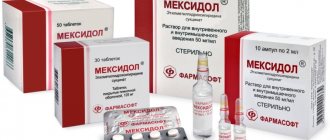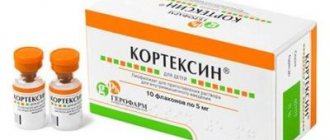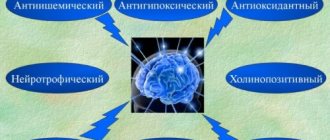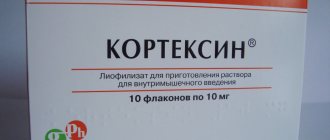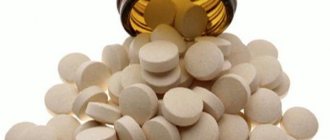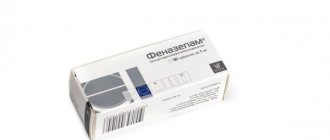pharmachologic effect
Manufacturer: numerous Russian and foreign
Release form: tablets, injection solution
Active ingredient: Vinpocetine
Vinpocetine 5 mg and Vinpocetine forte 10 mg are nootropic and psychostimulant drugs.
The main pharmacological properties are the following:
- improvement of metabolism in the brain;
- normalization of blood rheology;
- stimulating blood flow in the brain;
- reducing the effect of toxins on the functioning of the nervous system;
- neuroprotective properties;
- increase in ATP content in neurons;
- increased transport of glucose to nerve cells and fibers;
- antioxidant effect;
- reduction of blood viscosity due to inhibition of platelet aggregation;
- reduction of vascular resistance in the brain;
- improving blood transport to areas with ischemia and hypoxia;
- slight drop in pressure.
The complex effect on the body ensures the rapid onset of effects from the use of Vinpocetine and expands the scope of application.
Release form and composition
Vinpocetine is available in the form of tablets, oral solution, and injection. The tablets are presented in white color, have a round shape and a flat surface. Each tablet contains 5 mg of vinpocetine and auxiliary components such as starch, silicon dioxide, talc, lactose and others.
The solution for internal administration is characterized by a clear liquid that contains ascorbic acid, tartaric acid, water for injection, and sodium pyrosulfite.
Indications for use of Vinpocetine
The drug is prescribed for diseases of various areas:
- Neurological - encephalopathy with cognitive dysfunction, dizziness, headaches, acute disorders of blood flow in the brain, consequences of head injuries, atherosclerotic damage to cerebral vessels.
- Otolaryngological - hearing loss, especially in the elderly, Meniere's disease, hearing loss of various origins, dizziness due to damage to the hearing aid.
- Ophthalmological - vascular eye pathologies, atherosclerotic degenerative changes, consequences of vasospasms, vascular occlusion, secondary glaucoma.
Vinpocentine is prescribed in the complex therapy of these pathologies after examining the patient and assessing his condition.
Side effects and overdose
Side effects of the drug are varied and can affect almost every system of the body.
From the cardiovascular system the following is observed:
- discomfort in the chest area;
- tachycardia;
- arrhythmia;
- extrasystole;
- myocardial infarction;
- atrial fibrillation;
- heart failure;
- angina pectoris.
Metabolism:
- anorexia;
- diabetes;
- hypercholesterolemia.
Lymphatic and circulatory systems:
- thrombocytopenia;
- anemia;
- leukopenia;
- agranulocytosis.
Mental disorders:
- state of euphoria;
- overexcitement;
- irritability;
- depressive states;
- restlessness.
Photo: Side effects of Vinpocetine
Nervous system:
- weakness;
- sleep disturbance;
- dizziness;
- tremor;
- rare headaches (read the article about the best pills for headaches);
- lethargy;
- loss of consciousness;
- hemiparesis.
Digestive tract:
- abdominal discomfort;
- dyspepsia;
- heartburn;
- vomit;
- increased or decreased salivation.
Organs of vision:
- myopia;
- significant decrease in visual acuity;
- swelling of the optic nerve nipple;
- diplopia;
- hyphema;
- conjunctival hyperemia.
Hearing organs:
- hyperacusis;
- noise in ears;
- hypoacusia;
- hearing impairment.
Skin and subcutaneous tissues, immune system:
- hypersensitivity skin reactions;
- hyperhidrosis;
- erythema;
- itching;
- rashes;
- dermatitis;
- hives.
Reactions at the injection site and general reactions:
- thrombosis;
- feeling of heat;
- difficulty breathing;
- asthenia;
- inflammation.
An overdose of the drug causes increased side effects of Vinpocetine.
Vinpocetine - instructions for use
Vinpocetine tablets are used orally. Injectable forms of the drug are produced in ampoules. Doses and dosage regimens are selected by the doctor, taking into account the underlying disease and condition of the patient.
The medication is not prescribed to patients who are allergic to the components of the medication, or in childhood.
During pregnancy and lactation, the drug is used to a limited extent and only under the supervision of a doctor.
Possible side effects include:
- dyspepsia,
- swelling of the conjunctiva,
- headaches and dizziness,
- hypotension,
- weight gain,
- neurological disorders,
- rash,
- dermatitis,
- arrhythmias,
- myocardial infarction.
These disorders develop with irrational and very long-term use of Vinpocetine. Compliance with the dose is the only prevention of complications.
Dosage of Vinpocetine tablets
The drug is taken orally from 1 to 2 tablets three times a day. The duration of treatment is selected individually depending on the severity of the disease.
Dosage of injection forms
Vinpocetine in 5 mg/ml ampoules is administered only intravenously. The average dose per day is 20 mg.
How to take Vinpocetine: before or after meals
The tablets should be taken after meals. Wash down with at least 100 ml of clean water at room temperature without gas. The tablet is swallowed whole, do not crush or chew.
A decrease in the effectiveness of the drug may occur if there are violations of the rules for taking Vinpocetine, which are indicated in the instructions for use.
Precautions and possible complications
Each drug can cause some harm to the body if used incorrectly. To avoid side effects, special instructions should be taken into account before using Vinpocetine.
What do you need to consider?
For safe use, it is important to follow these recommendations:
- In the acute phases of the disease, the drug is administered by drip or injection. After achieving the effect, treatment with tablets should be continued.
The drug is incompatible with heparin. They should not be administered at the same time (especially in the same syringe), as this increases the risk of bleeding.- The drug should not be administered in the acute stage of a hemorrhagic stroke. It is used after acute symptoms have subsided (usually after a week).
- Use the drug with caution in the treatment of patients with bradycardia.
- Older people have an increased risk of side effects. This is due to the fact that they have increased sensitivity of brain vessels to the relaxing effect of the drug.
- The drug should be stored in a place protected from direct sunlight at temperatures up to 25 degrees Celsius.
- After opening the solution for droppers or injections, it can be stored for no more than 3 hours.
- Do not use the product after the expiration date.
- Use the drug with caution if the patient has liver disease (especially liver failure).
- The drug penetrates the placental barrier and into breast milk, which has a toxic effect on the baby. Therefore, it is not used in the treatment of pregnant women and nursing mothers.
When using Vinpocetine to treat patients with diabetes, it is necessary to monitor blood glucose levels.- The drug does not affect the reaction rate when driving vehicles. But the risk of adverse reactions should be taken into account.
- Vinpocetine in ampoules cannot be diluted with solutions that contain amino acids.
If you use the medicine correctly, taking into account all contraindications and following special instructions, the risk of side effects and negative reactions is significantly reduced.
Vinpocetine analogs
The drug is produced by various pharmaceutical companies. Its composition and release forms are completely identical. The only differences are in manufacturers and costs. The most popular Vinpocetine on the market is from the following companies:
- Gedeon Richter, Hungary,
- Sintez, Russia,
- Obolenskoye FPO, Russia,
- Kanonpharma, Russia,
- Pharmproject,
- Izvarino,
- North Star,
- Welfarm.
Direct imported analogues and substitutes for Vinpocetine are Cavinton, Cavinton forte 10 mg in different release forms and dosages. Manufacturer: Gedeon Richter, Hungary. They are original drugs for which all the necessary studies on safety and effectiveness have been carried out.
In some cases, doctors replace Vinpocetine with analogues of the drug, including the new generation. Such products differ in composition, release forms and manufacturers, but have a similar effect on the body. Analogues of the drug include the following:
- based on citicoline - Ceraxon, Somazina;
- containing Phenibut - Noofen;
- combination drugs based on vinpocetine, piracetam and cinnarizine - Vinpotropil, Phezam, Omaron;
- medications containing piracetam - Nootropil, Lucetam;
- Picamilon;
- drugs based on cinnarizine - Stugeron;
- analogues that contain betahistine - Betaserc, Vestibo, Tagista;
- gama-aminobutyric acid - Aminalon, Olatropil;
- Glycine;
- Cortexin;
- Mebicar;
- Noopept;
- pramiracetam (new generation) - Pramistar;
- Cerebrolysin;
- Pantogam;
- new generation idebenone as part of the Noben analogue;
- pentoxifylline, which is contained in Trental;
- products with a combined composition that affect the nervous system - Cytoflavin, Vasobral, Actovegin;
- analogues based on Ginkgo Biloba - Tanakan, Bilobil;
- active substance nicergoline and drugs based on it - Sermion, Niceromax.
List of Vinpocetine analogues with prices.
| Name | Active substance | Manufacturer | Release form | Cost of minimum packaging and dose |
| Vinpocetine | Vinpocetine | Gedeon Richter | Pills | From 100 rub. |
| Vinpocetine | Pharmproject | From 55 rub. | ||
| Vinpocetine | Borisov plant | Ampoules 2 ml | From 75 rub. | |
| Cavinton | Gedeon Richter | Pills | From 109 rub. | |
| Cerakson | Citicoline | Ferrer, Spain | Oral solution | From 680 rub. |
| Noofen | Phenibut | Olaipharma | Capsules | From 980 rub. |
| Vinpotropil | Vinpocetine, Piracetam | Canonpharma | Pills | From 390 rub. |
| Omaron | Piracetam, Cinnarizine | Hemofarm | From 130 rub. | |
| Nootropil | Piracetam | UCB | From 250 rub. | |
| Picamilon | Picamilon | Pharmstandard | From 95 rub. | |
| Stugeron | Cinnarizine | Gedeon Richter | From 180 rub. | |
| Tagista | Betagistine | Hemofarm | From 80 rub. | |
| Betaserk | Betagistine | Veropharm | From 555 rub. | |
| Aminalon | Gamma-aminobutyric acid | Borisovsky | From 130 rub. | |
| Glycine | Glycine | Biotics | From 30 rub. | |
| Cortexin | Polypeptides | Geropharm | Powder for preparing solution | From 1300 rub. |
| Noopept | Noopept | Pharmstandard | Pills | From 340 rub. |
| Pantogam | Hopantenic acid | Vips-Med | From 370 rub. | |
| Noben | Idebenon | Binnopharm | Capsules | From 550 rub. |
| Trental | Pentoxifylline | Sanofi | Pills | From 570 rub. |
| Vasobral | Ergocryptine, Caffeine | Pharmstandard | From 970 rub. | |
| Cytoflavin | Amino acids | Polisan | From 400 rub. | |
| Tanakan | Ginkgo biloba | Bofur | From 600 rub. | |
| Sermion | Nicergoline | Pfizer | From 520 rub. |
General information about Vinpocetine
The medication, in addition to its vasodilating properties, has the following effect on the patient’s body:
- antiaggregation;
- antihypoxic;
- antioxidant;
- improving blood flow.
Drug group, INN
Vinpocetine belongs to the pharmacological group of nootropic medications that stimulate brain functionality. The drug is classified as a psychoanaleptic. INN – Vinpocetine.
Forms of release and price of Vinpocetine
Vinpocetine is made in tablets and also in a solution for injections. The tablets are white and round in shape and have no odor with the active ingredient vinpocetine (5 mg). Tablets are packaged in blisters of 10 pieces. The box contains 1, 3, 5 blisters and instructions for using the medication
The solution for injections (concentrate for making a solution for infusion) is packaged in ampoules of 2 ml. There are 5.10 ampoules in a cardboard box, as well as an annotation for this medicine. Average price of Vinpocetine in Russia:
| Release form of the medicine | Number of pieces in 1 package | Dosage of the main component (mg) | average cost |
| Pills | 30 | 5 | 40-80 |
| Pills | 50 | 5 | 91-101 |
| Solution in ampoules | 5 mg/ml | 5 | 50-80 |
Compound
In addition to vinpocetine, which exists in the same dosage in tablets and solution (5 mg), there are additional ingredients that differ in both dosage forms. In solution:
- ascorbic and tartaric acid;
- sorbitol;
- sodium metabisulfite;
- benzyl alcohol and water.
In tablets:
- hypromellose and magnesium stearate;
- corn starch and talc;
- silica.
The tablets also contain lactose, which must be taken into account when prescribing to patients with lactose intolerance.
Pharmacodynamics and pharmacokinetics
Vinpocetine is the main component in the medicine. It has the following effects on the brain:
- increased blood flow in the cerebral arteries;
- restoration of metabolism in brain cells (neurons);
- improving the supply of glucose and oxygen to the brain;
- improvement of the rheological properties of blood.
The principle of operation of vinpocetine is to block the cytotoxic effect of excitatory amino acids on the brain. Vinpocetine also blocks sodium and calcium channels. By supplying glucose and oxygen to the brain, the functionality of areas affected by ischemia is restored.
Properties of the drug
Also, the active component stimulates the neurotransmitter system and improves the metabolic processes of the hormones serotonin and norepinephrine. Cerebral blood flow is improved by reducing blood viscosity due to inhibition of platelet adhesion, which helps reduce the risk of intravascular thrombus formation in the cerebral arteries.
Improving blood flow in the brain contributes to the rapid recovery of cognitive functions after cerebral ischemia and stroke:
- memory is restored quickly;
- there is a gradual restoration of the functions of the speech and motor apparatus;
- the patient’s intellectual abilities are restored;
- The ability to concentrate and think returns.
Mechanism of action
Pharmacokinetics:
- absorption in the gastrointestinal tract is quite rapid;
- the maximum concentration of vinpocetine in the blood serum occurs 60 minutes after oral administration and 20-30 minutes after intravenous administration;
- binding to plasma proteins – 66%;
- bioavailability – 50-70%;
- metabolized in liver cells into the main metabolite apovincamic acid;
- half-life – 5 hours;
- excreted from the body by the kidneys with urine - 60%, and by the liver with feces - 40%;
- the medication does not have the ability to accumulate in the body;
- pharmacokinetics in different age groups of patients is the same.
Vinpocetine Acree
Unlike Vinpocetine, Vinpocetine Acree (Russian manufacturer) is available only in the form of flat tablets, with a dosage of the main component of 5 mg. The tablets are packaged in blisters of 25 pieces and 2 blisters are included in a cardboard box.
This medication has the same active ingredient as Vinpocetine, so their mechanisms of action are identical.
Both medications can replace each other in therapy. However, the drug from Acri contains pyrogenic silicon dioxide, which increases the bioavailability of the drug.
Vero-Vinpocetine
The Russian-made vasodilating drug Vero-Vinpocetine is manufactured in tablet form. This is the main difference between both medications. The tablets are packaged in polymer jars of 50 pieces or in a cardboard box of 5 blisters (10 pieces per blister). The drug has a composition identical to Vinpocetine and identical purposes and contraindications.
Analogs
Analogues of this nootropic medication can be structural analogues based on vinpocetine, as well as therapeutic analogues that contain other active components and mechanism of action, but have the same therapeutic effect:
Vinpocetine Forte Canon is a Russian structural analogue that increases the resistance of neurons to hypoxia. The medication is prescribed for cerebral ischemia of various etiologies and during the rehabilitation period after a hemorrhagic stroke. The drug is also often used to treat brain pathologies of traumatic and sclerotic origin;- Korsavin Forte is a vasodilator that improves blood flow in ischemic areas of the brain, and also blocks platelet aggregation and increases the release of oxygen from red blood cells to the cell membranes of neurons. The drug reduces the resistance of cerebral arteries without changing systemic parameters;
- Piracetam is a therapeutic substitute for Vinpocetine, based on the active ingredient piracetam. Piracetam therapy involves filling all parts of the brain with oxygen. Piracetam is able to restore the brain in a short period of time after a transient ischemic attack, hypoxia, and ischemic stroke. Taking the medication begins in the first hours of the development of a stroke attack. Piracetam is available in tablets and solution for injections;
- Cavinton is a medicinal nootropic drug based on vinpocetine. Cavinton increases cerebral microcirculation and also improves intracellular metabolism. The medication is used to treat neurological, mental and cardiac pathologies of traumatic and vascular etiology.
See also:
Cavinton Comforte - instructions for use, reviews, differences and analogues
Vinpocetine and Cavinton - which is better and more effective, what is the difference
Manufacturer: Gedeon Richter, Hungary
Release form: tablets, dispersible tablets, ampoules
Active ingredient: Vinpocetine
Cavinton and Vinpocetine are complete analogues with the same composition. The clinical effects of using the drugs are the same. According to some doctors, Cavinton, being an original drug, exhibits higher efficiency and better tolerability.
Cavinton dosage: 1-2 tablets three times a day after meals or 20 mg per day for injection forms. These analogues are not intended for children. Safer drugs should be selected for their treatment.
Differences between analogue drugs in manufacturers. Cavinton is an imported analogue of Vinpocetine in tablets and injections, its price is higher.
Bottom line
Vinpocetine and Cavinton are almost identical drugs, they are indicated in similar cases and contain the same main substance. Cavinton has several more auxiliary components, and its cost is 3 times more. This is explained by the fact that the product is produced by the reputable Hungarian company Gedeon Richter. It has been popular for many years in the market and is considered a reliable pharmaceutical manufacturer.
The low cost of vinpocetine is due to the fact that the product is produced by small Russian enterprises, little known to consumers. Doctors more often prescribe Cavinton to patients, confidence in its quality is higher, and practice shows that treatment is quite easily tolerated by patients.
It is impossible to say for sure which drug is better. The decision remains with the consumer - to choose a high-quality foreign analogue or an inexpensive domestic medicine.
Vinpocetine or Piracetam - which is better?
Manufacturer: Ozone, Grotex, Obolenskoe
Release form: tablets, capsules, injection solutions
Active ingredient: Piracetam
Synonyms: Lucetam, Nootropil, Piramem, Stamin, Pyrabene
Piracetam and Vinpocetine belong to the group of nootropic drugs. Analogs differ in composition, mechanism of action, manufacturers, and release forms.
Differences between analogue drugs explain the difference in indications for use. For Piracetam, the main action is aimed at correcting cognitive functions. Vinpocetine, in addition to correcting cognitive functions, is widely used in neurology for dizziness, blood circulation disorders, including those due to cervical osteochondrosis, injuries and other pathologies. The speed of onset of effects is higher with Piracetam and its analogues.
Piracetam dosage: daily dose from 1.2 g to 2.4 g orally or intravenously. According to reviews from patients and doctors, the drug is well tolerated. Not prescribed for children. Elderly dose adjustment is not required.
Vinpocetine or Cinnarizine - which is better?
Manufacturer: Sopharma, Atoll
Release form: tablets
Active ingredient: Cinnarizine
Synonyms: Stugeron, Cinazine, Cinnarizine-forte, Cyrizine, Vertizine
Cinnarizine and Vinpocetine are analogues in action - both drugs exhibit nootropic properties. They are used orally to treat a number of diseases specified in the instructions for use.
Cinnarizine is characterized by specific indications for use, which include disorders of not only cerebral blood flow, but also peripheral ones. This makes it possible to use the analogue for the treatment of varicose veins, thrombosis, trophic ulcers, and paresthesia.
Dosage of Cinnarizine: 1-3 tablets three times a day, depending on the nature of the disease.
Interaction
- Vinpocetine is not prescribed with heparin. This drug interaction may result in bleeding.
- When prescribed with α-methyldopa, it should be used with caution and constant blood pressure monitoring is required.
- Vinpocetine is prescribed with caution with drugs that may have an effect on the central nervous system, as well as with anticoagulant, antiarrhythmic and fibrinolytic agents.
In these cases, the use should be coordinated with your doctor.
Vinpocetine or Mexidol - which is better and more effective, what is the difference
Manufacturer: Zdorovye, Russia
Release form: tablets, solution for infusion, ampoules
Active ingredient: Ethylmethylhydroxypyridine succinate
Synonyms: Armadin, Dinar, Mexiprim, Neurotropin, Elfunat
Mexidol is a complex analogue of Vinpocetine, which affects not only blood flow in cerebral vessels, but also improves metabolic and energy processes in the body. The range of indications for use of the drug is wider and has differences: cardiac ischemia, asthenia, neuroses.
The doctor selects the remedy that is most suitable for the patient after collecting an anamnesis and making a diagnosis. Positive reviews from patients indicate the high effectiveness of the drug as a nootropic agent.
Both analogues are intended for both internal use and intravenous administration. Mexidol dosage: from 125 to 250 mg of the drug per day. Vinpocetine and Mexidol are not used in children due to insufficient safety studies.
Vinpocetine or Phezam - which is better?
Manufacturer: Actavis
Release form: capsules
Active ingredient: Piracetam, Cinnarizine
Synonyms: Omaron
Phezam is a more expensive analogue of Vinpocetine. The composition of the drugs is different, but they are united by a similar nootropic effect on the body. Also, analogues have different manufacturers and release forms. The similarity of indications and contraindications allows us to consider it a full-fledged substitute for Vinpocetine.
Dosage of Phezam: from 1 to 3 capsules orally three times a day after meals. The drug is not used in children.
Vinpocetine and Picamilon - which is better?
Manufacturer: Pharmstandard
Release form: tablets
Active ingredient: Picamilon
Synonyms: Picanoil, Amylonosar
Picamilon is an analogue that, in addition to its nootropic effect, has a pronounced vasodilating effect. Due to this, the spectrum of action of the drug is wider than that of Vinpocetine.
Picamilon is used in urology, cardiology, sports medicine, mental, and neurological disorders.
Dosage of the drug: daily dose from 60 to 150 mg of the active substance, regardless of meals.
Differences between analogues in composition and manufacturers. Therefore, they are combined in complex therapy as prescribed by a doctor.

